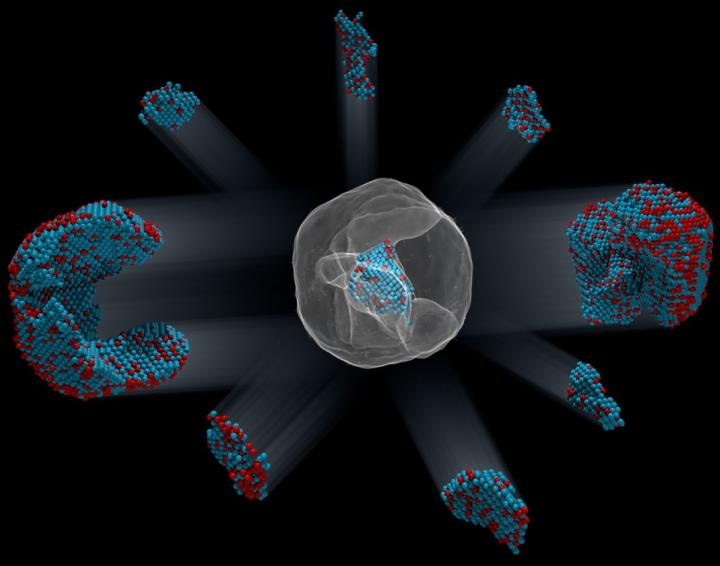Feb 2 2017
 Identification of the 3D coordinates of 6,569 iron and 16,627 platinum atoms in an iron-platinum nanoparticle to correlate 3D atomic arrangements with material properties at the single-atom level. (CREDIT - Courtesy of Colin Ophus and Florian Nickel)
Identification of the 3D coordinates of 6,569 iron and 16,627 platinum atoms in an iron-platinum nanoparticle to correlate 3D atomic arrangements with material properties at the single-atom level. (CREDIT - Courtesy of Colin Ophus and Florian Nickel)
Perfection is very rate in the world of the minuscule: nearly all materials have flaws on the atomic level. Imperfections such as atoms of one type swapped for another, missing atoms, and misaligned atoms can uniquely decide a material’s properties and function.
Recently, UCLA physicists and collaborators have mapped the coordinates of over 23,000 individual atoms in a miniature iron-platinum nanoparticle to expose the material’s flaws.
The results show that the positions of numerous atoms can be identified precisely and then incorporated into quantum mechanic calculations to link imperfections and flaws with material properties at the single-atom level. The details of this research have been published in the February 2 issue of the Nature journal.
Jianwei “John” Miao, a UCLA professor of physics and astronomy and a member of UCLA’s California NanoSystems Institute, headed the international team in mapping the atomic-level specifics of the bimetallic nanoparticle, over a trillion of which could fit inside a grain of sand.
No one has seen this kind of three-dimensional structural complexity with such detail before.
Jianwei Miao, Professor, UCLA
Miao is also a deputy director of the Science and Technology Center on Real-Time Functional Imaging.
This new National Science Foundation-funded consortium comprises of researchers at UCLA and five other universities and colleges who are using high-resolution imaging to answer queries in the life sciences, physical sciences, and engineering.
Miao and his team examined an iron-platinum alloy, a highly promising material for permanent magnet and advanced magnetic storage media applications.
The team was able to establish the precise 3D arrangement of atoms in the nanoparticle by capturing numerous images of the iron-platinum nanoparticle with an advanced electron microscope at Lawrence Berkeley National Laboratory and using powerful reconstruction algorithms developed at UCLA.
“For the first time, we can see individual atoms and chemical composition in three dimensions. Everything we look at, it’s new,” Miao said.
The team identified and located over 16,600 platinum and 6,500 iron atoms and showed how those atoms were set in nine grains, each of which have varying ratios of platinum and iron atoms. Miao and his colleagues revealed that atoms nearer to the interior of the grains were more regularly set than those close to the surfaces. They also highlighted that the interfaces between grains, known as grain boundaries, were more not properly arranged.
Understanding the three-dimensional structures of grain boundaries is a major challenge in materials science because they strongly influence the properties of materials. Now we are able to address this challenge by precisely mapping out the three-dimensional atomic positions at the grain boundaries for the first time.
Jianwei Miao, Professor, UCLA
Next, the researchers used the 3D coordinates of the atoms as inputs into quantum mechanics calculations to establish the magnetic properties of the iron-platinum nanoparticle. They noticed unexpected changes in magnetic properties at the grain boundaries.
“This work makes significant advances in characterization capabilities and expands our fundamental understanding of structure-property relationships, which is expected to find broad applications in physics, chemistry, materials science, nanoscience and nanotechnology,” Miao said.
In the days to come, when the team continues to establish the 3D atomic coordinates of more materials, they plan to set up an online databank for the physical sciences, similar to protein databanks for the life and biological sciences. “Researchers can use this databank to study material properties truly on the single-atom level,” Miao said.
Miao and his team are also keen on using their technique called GENeralized Fourier Iterative Reconstruction (GENFIRE) to medical and biological applications. “Our three-dimensional reconstruction algorithm might be useful for imaging like CT scans,” Miao said. Compared with traditional reconstruction methods, GENFIRE requires lesser images to assemble an accurate 3D structure. This would mean that radiation-sensitive objects can be imaged using lower doses of radiation.
The co-authors of the study include Yongsoo Yang, Rui Xu, AJ Pryor, Li Wu and Jihan Zhou, all at UCLA; Mary Scott, Colin Ophus, and Peter Ercius of Lawrence Berkeley National Laboratory; Chien-Chun Chen of the National Sun Yat-sen University; Fan Sun and Hao Zeng of the University at Buffalo; Markus Eisenbach and Paul Kent of Oak Ridge National Laboratory; Wolfgang Theis of the University of Birmingham; and Renat Sabirianov of the University of Nebraska Omaha.
This research was supported by the U.S. Department of Energy’s Office of Basic Energy Sciences as well as the U.S. National Science Foundation’s Division of Materials Research.